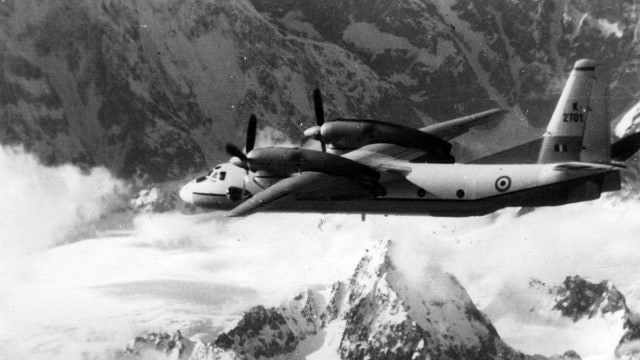Military Digest: AN-32 and C-130 in Kargil revive memories of 2002 missile incident
Air Vice Marshal A C Chafekar has written a detailed account of the event in his book ‘Shades of Blue’.
 An AN-32 of a Chandigarh-based squadron hit the headlines in 2002 when an aircraft was shot and hit by a Pakistani missile after it strayed into Pakistan Occupied Kashmir while attempting a landing at Kargil ALG. (Express archive photo/File)
An AN-32 of a Chandigarh-based squadron hit the headlines in 2002 when an aircraft was shot and hit by a Pakistani missile after it strayed into Pakistan Occupied Kashmir while attempting a landing at Kargil ALG. (Express archive photo/File)In the past few days, the Kargil airfield in Ladakh has been in the news for varied reasons. A C-130J Super Hercules aircraft of the Indian Air Force (IAF) did a first night landing at the airfield, and an AN-32 courier service was inaugurated too.
The inaugural courier flight transported 11 passengers from Kargil to Jammu and seven from Jammu to Kargil, operated by IAFs Chandigarh-based AN-32 Squadron.
An AN-32 of a Chandigarh-based squadron hit the headlines in 2002 when an aircraft, flown by the then flight commander, who later commanded a squadron in Chandigarh and was also Air Officer Commanding 12 Wing, Chandigarh, was shot and hit by a Pakistani missile after it strayed into Pakistan Occupied Kashmir (Pok) while attempting a landing at Kargil ALG.
The episode had been reported and covered in detail by this correspondent from Leh, and the subsequent events had led to a huge furore as an air marshal was held responsible for the error. Attempts were made to pin the blame on the flight commander, but these did not succeed, and he eventually retired as an Air Vice Marshal.
Air Vice Marshal A C Chafekar, the pilot in that eventful flight who was sought to be blamed, has written a detailed account of that event in his book Shades of Blue.
Chafekar has carried out two landings in Kargil, the first one on March 16, 2001, when one fine day he was told to station his aircraft at Delhi from where the AOC-in-C Western Air Command was to fly to Kargil with him. Air Marshal VK Bhatia was the AOC-in-C and he was to fly in the Captain’s seat even though he was not qualified to fly AN-32 aircraft.
Since the event was the inauguration of the airfield, the Air Marshal was keen to be seen flying into the landing strip himself. Chafekar writes that he wanted a qualified co-pilot on this flight because of the challenges in landing at Kargil, as it is close to the Line of Control (LoC) with Pakistan and is surrounded by high hills.
However, his apprehensions to his commanding officer were not addressed, and the flight took place as scheduled on February 19, 2001, from New Delhi.
The route planned was Delhi report overhead-Chandigarh report overhead-Leh-Fatu La (a prominent reporting point short of Kargil)-Kargil. Short of Leh, Air Marshal Bhatia wanted to turn left and set a course directly for Kargil instead of reporting overhead Leh as planned, writes Chafekar. It appears he wanted to save time.
“Short of Fatu La, he announced that we will commence descent and report directly on base leg and final approach Kargil. I was surprised by this unusual announcement. I explained him that during both trial landings I had followed a procedure of reporting overhead Kargil maintaining route altitude 22,000 feet and then descending overhead after siting the runway, to feed into circuit pattern for landing,” he writes.
The objections were brushed aside and to cut a long story short the inevitable happened. The crew only realised that something was wrong when they experienced a loud ‘thud’, the aircraft viciously yawed and a fire warning came up in the cockpit control panel. A shoulder-fired Pakistani missile had hit the aircraft.
Chafekar mentions that the crew initiated emergency recovery measures but not without interference by the Air Marshal who still wanted to land at Kargil! And when a stern ‘no’ was sounded to him and a course set for Leh, he still wanted to fly the aircraft to Leh.
Upon landing at Leh, the damage to the aircraft was seen with horror by all. “We were shocked to see the state of the aircraft. Aircraft right engine was damaged and appeared to be because of a missile hit….the missile has ripped off the engine. It appeared that the missile fuses, namely heat seeking and impact fuse, had malfunctioned and the missile went through the engine as a projectile. The angle at which the missile hit caused the least damage and was the main reason we survived. The impact slightly lower would have damaged the main body of aircraft (fuselage), impact at slightly higher angle would have dislodged the wing from the aircraft,” wrote Chafekar.
What followed this incident is a story in itself and will be recounted in detail in the next edition of this column. But readers will be amused to know that on the flight back to New Delhi, in another aircraft, the Air Marshal still sat on the left-hand Captain’s seat in the cockpit.







